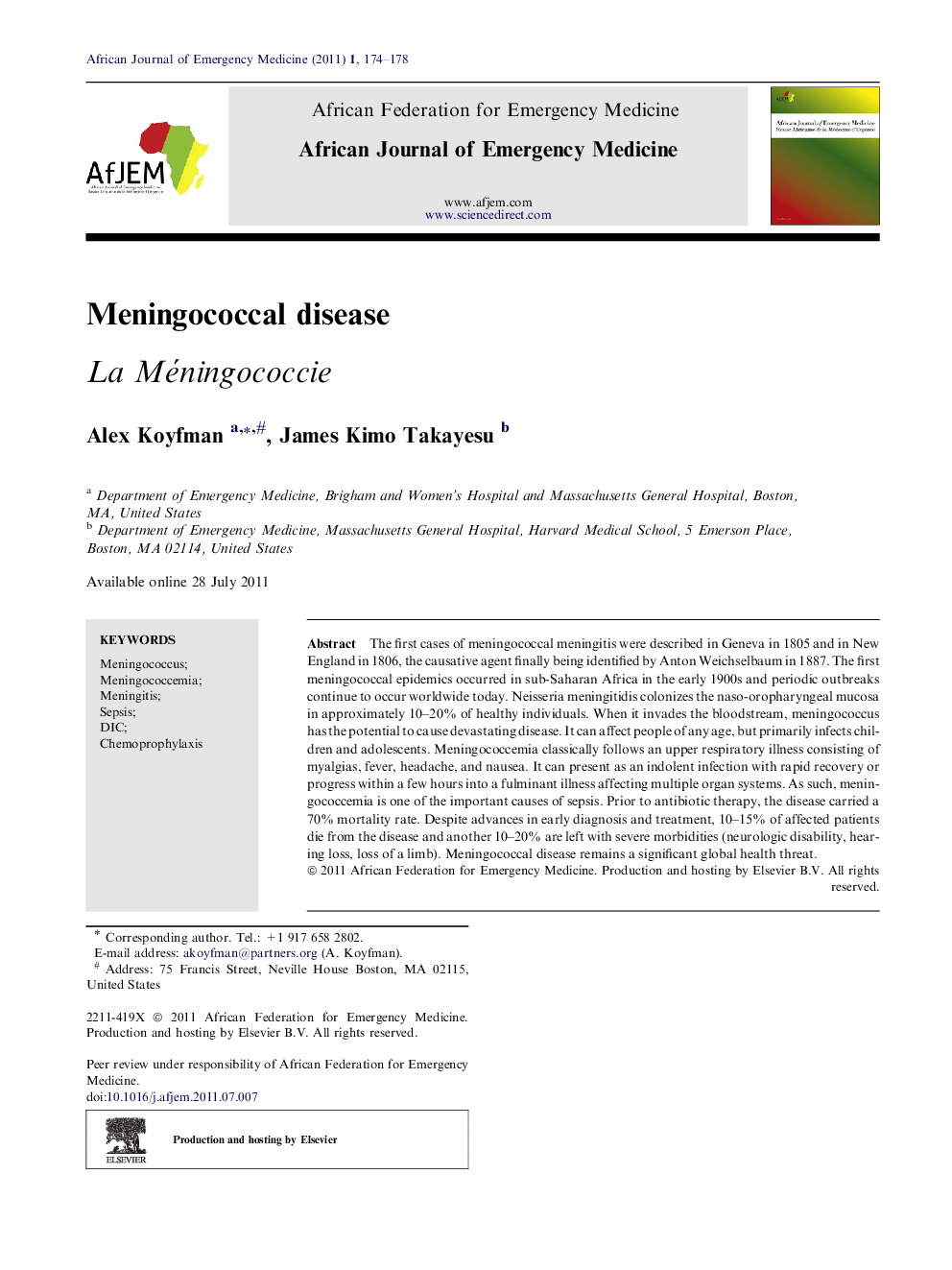| Article ID | Journal | Published Year | Pages | File Type |
|---|---|---|---|---|
| 3223005 | African Journal of Emergency Medicine | 2011 | 5 Pages |
The first cases of meningococcal meningitis were described in Geneva in 1805 and in New England in 1806, the causative agent finally being identified by Anton Weichselbaum in 1887. The first meningococcal epidemics occurred in sub-Saharan Africa in the early 1900s and periodic outbreaks continue to occur worldwide today. Neisseria meningitidis colonizes the naso-oropharyngeal mucosa in approximately 10–20% of healthy individuals. When it invades the bloodstream, meningococcus has the potential to cause devastating disease. It can affect people of any age, but primarily infects children and adolescents. Meningococcemia classically follows an upper respiratory illness consisting of myalgias, fever, headache, and nausea. It can present as an indolent infection with rapid recovery or progress within a few hours into a fulminant illness affecting multiple organ systems. As such, meningococcemia is one of the important causes of sepsis. Prior to antibiotic therapy, the disease carried a 70% mortality rate. Despite advances in early diagnosis and treatment, 10–15% of affected patients die from the disease and another 10–20% are left with severe morbidities (neurologic disability, hearing loss, loss of a limb). Meningococcal disease remains a significant global health threat.
ResuméLes premiers cas de méningite à méningocoques ont été décrits à Genève en 1805 et en Nouvelle Angleterre en 1806, l’agent causal de la maladie étant finalement identifié par Anton Weichselbaum en 1887. Les premières épidémies de méningococcie se sont présentées en Afrique subsaharienne au début du 20è siècle et des épidémies régulières se produisent toujours de nos jours dans le monde. Neisseria meningitidis colonise la muqueuse rhino-oropharyngée chez 10 à 20% environ des personnes en bonne santé. Lorsqu’elle envahit le système sanguin, Neisseria meningitidis peut provoquer une maladie dévastatrice. Elle peut affecter des personnes de tout âge, mais infecte principalement les enfants et les adolescents. La méningococcémie suit généralement une maladie des voies respiratoires supérieures consistant en myalgie, fièvre, maux de tête et nausées. Elle peut se présenter sous forme d’infection à la malignité réduite avec guérison rapide ou progresser en quelques heures en une maladie foudroyante affectant de multiples organes. C’est pourquoi la méningococcémie est l’une des causes importantes de la septicémie. Avant l’arrivée des traitements antibiotique, la maladie était associée à un taux de mortalité de 70%. En dépit des progrès réalisés en matière de diagnostic et de traitement, 10 à 15% des patients affectés décèdent de la maladie et 10 à 20% supplémentaires souffrent de morbidités graves (handicap neurologique, perte d’audition, perte d’un membre). La méningococcie est toujours une menace sanitaire mondiale importante.
▸ Meningococcal disease is a significant global health threat. Neisseria meningitidis is an encapsulated gram-negative diplococcus that can cause a wide spectrum of disease from a benign infection to septic shock. ▸ Any patient presenting with fever, headache, nausea, vomiting, myalgias, and a maculopapular or petechial rash should prompt the consideration of meningococcal infection. ▸ The antibiotic of choice is high-dose intravenous ceftriaxone because of its good CSF penetration. Antibiotic prophylaxis is recommended for individuals with close contact to the patient.
